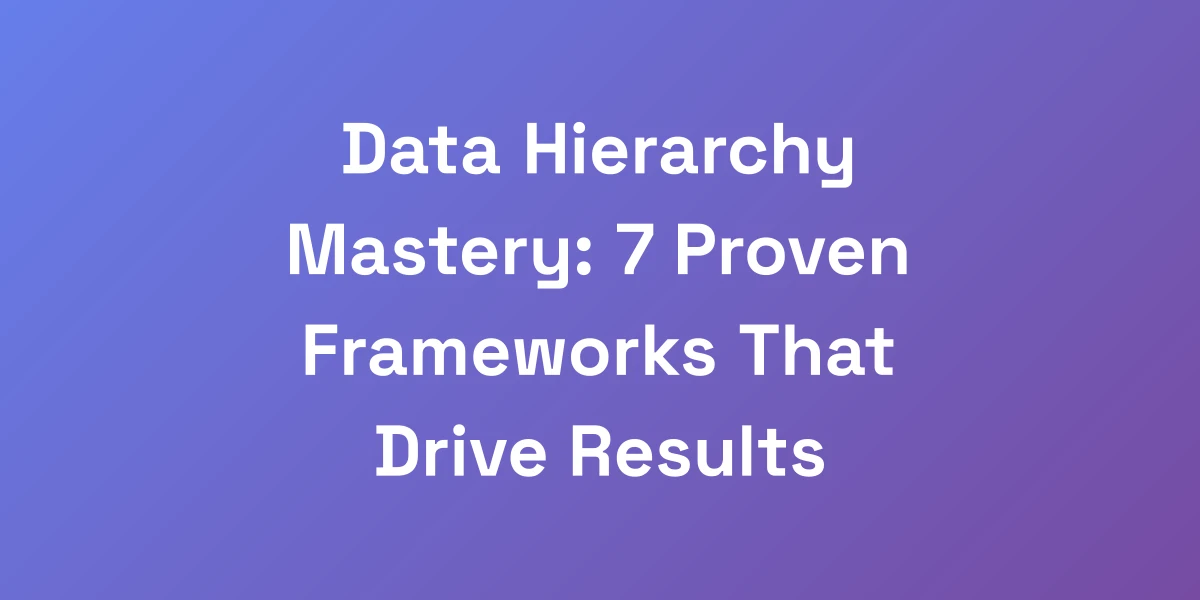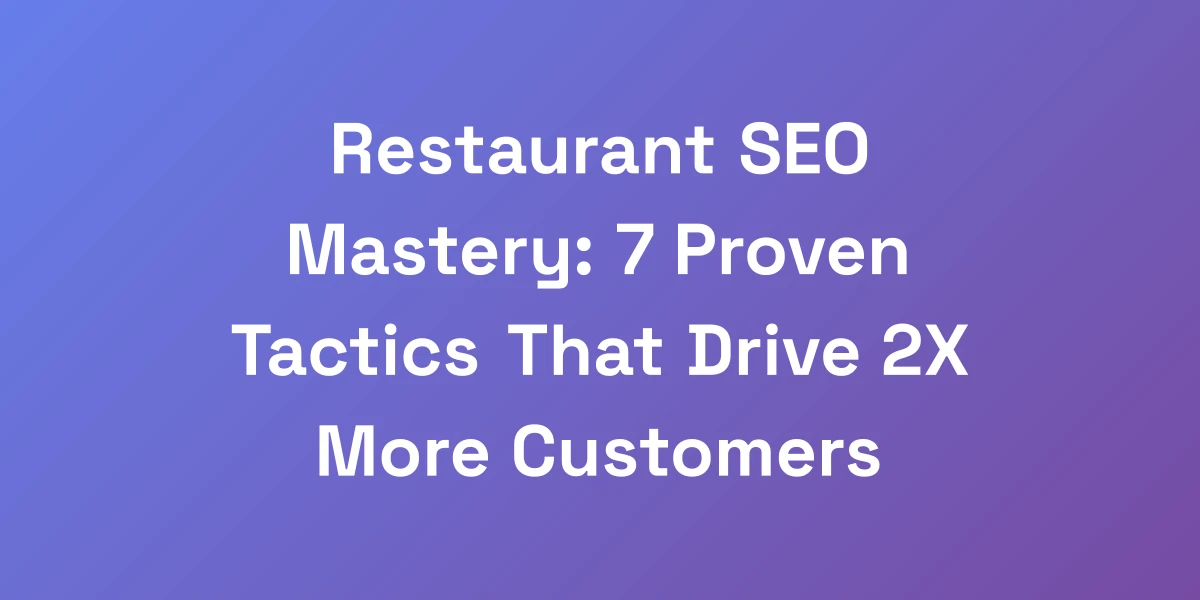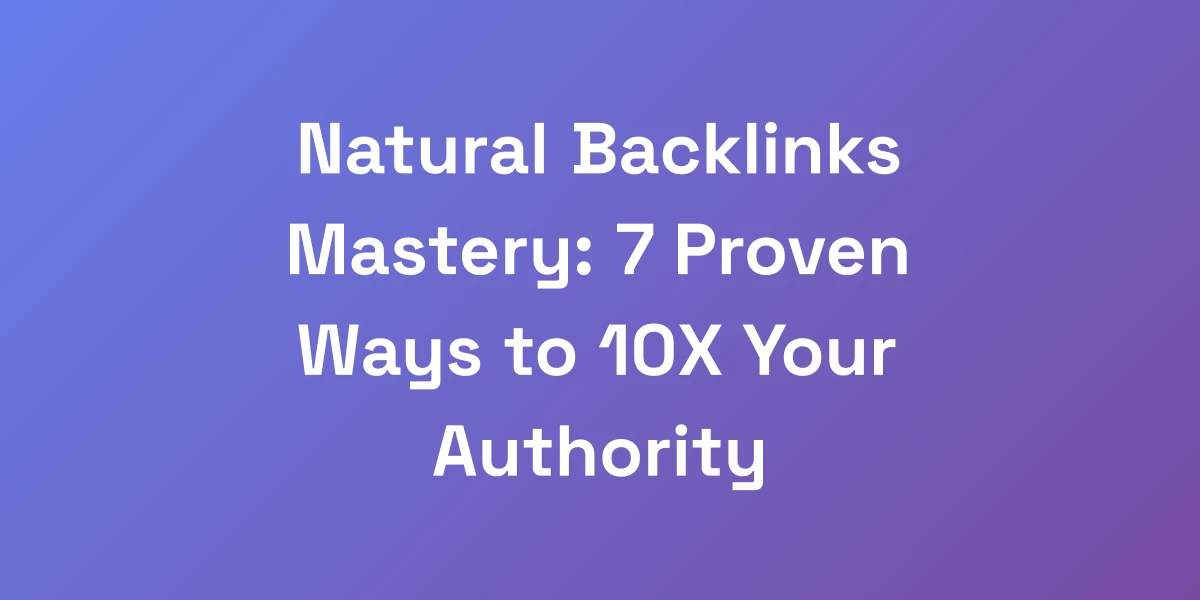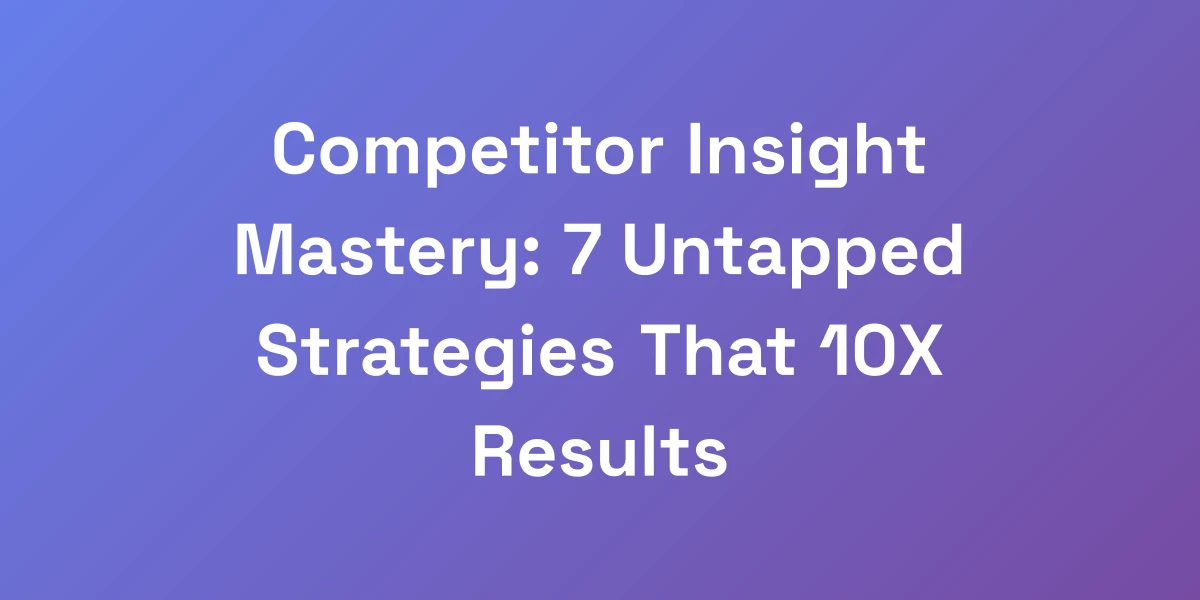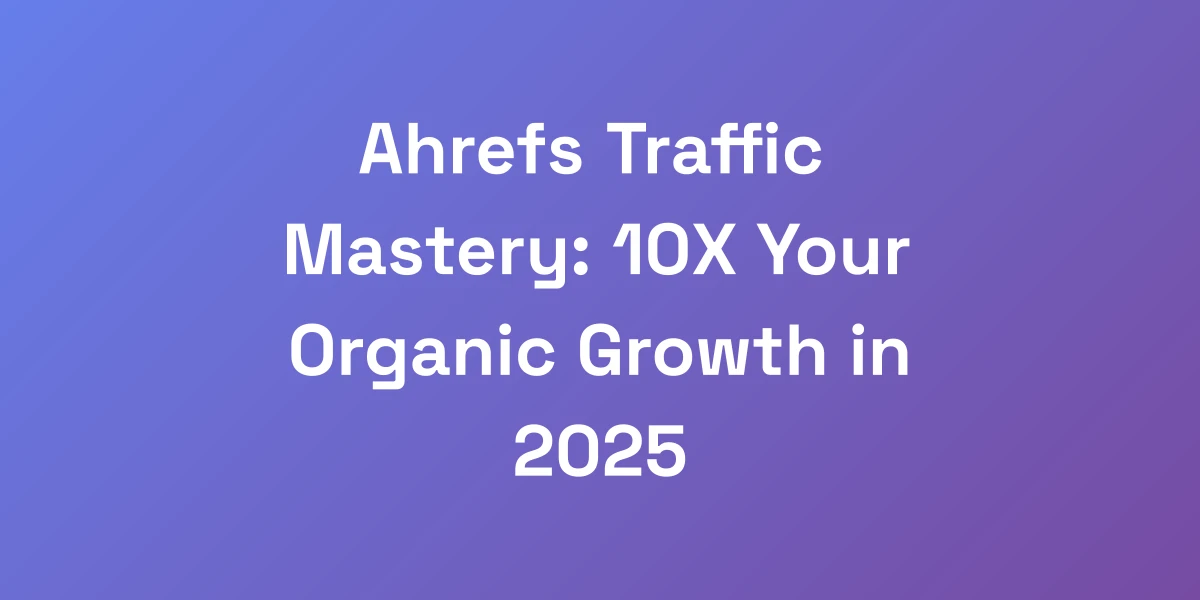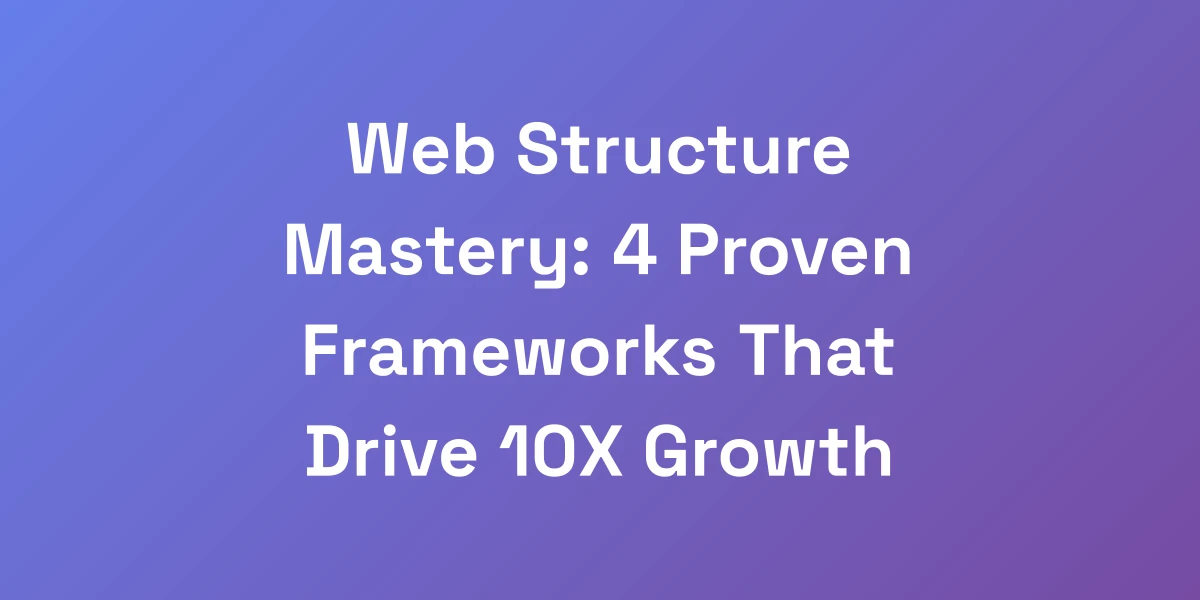
Web Structure Mastery: 4 Proven Frameworks That Drive 10X Growth
Mar 14, 2025 | By [email protected]
Introduction
We’re about to unveil the secret weapon that most businesses overlook in their quest for online domination: web structure. Imagine your website as a well-oiled machine—everything in its right place, working seamlessly to convert visitors into loyal customers.
But here’s the kicker: 90% of businesses get this wrong, leaving countless opportunities on the table. Why? They treat their website structure as a mere afterthought instead of the powerhouse it truly is. This oversight can cripple your conversion rates and stunt your growth potential.
Are you ready to flip the script and join the elite 1% that master their web structure for 10X growth? Let’s dive deep into the frameworks that can transform your website from a passive online presence to a relentless revenue-generating machine.
The Hidden Power of Web Structure (And Why 90% Get It Wrong)
Listen, here’s the raw truth about web structure that nobody’s talking about: it’s the silent killer of conversion rates. We’ve seen businesses hemorrhaging money because they treated their website structure like an afterthought. But here’s what’s crazy – the companies crushing it online? They’re not just randomly throwing pages together. They’re using strategic architecture that turns visitors into customers.
We’re about to show you exactly how the top 1% are structuring their websites to maximize both user engagement and search engine visibility, and why it’s the most undervalued asset in your digital arsenal.
The Real Cost of Poor Web Structure (With Revenue Impact)
Poor web structure doesn’t just affect user experience—it directly impacts your bottom line. Let’s break it down:
- High Bounce Rates: Websites with disorganized structures see bounce rates exceeding 70%, signaling users are leaving without engaging. This alone can cost you thousands in lost revenue monthly.
- Lower Conversion Rates: Without a clear path, visitors get lost. Conversion rates can drop by up to 50% when structure fails to guide users effectively.
- SEO Penalties: Search engines love well-structured sites. Messy architectures can lead to poor crawlability, resulting in lower search rankings and reduced organic traffic.
Consider a retail website that poorly organizes its products. Users struggle to find what they need, abandon their carts, and your revenue plummets. This isn’t hypothetical—it’s happening right now across industries.
Why Traditional Web Structure Advice Is Outdated
The old-school advice of “just make it look good” no longer cuts it. Modern users expect intuitive navigation, personalized experiences, and rapid load times.
- Static Hierarchies: Traditional fixed hierarchies fail to adapt to diverse user journeys and dynamic content needs.
- One-Size-Fits-All: Uniform structures ignore the unique pathways different user segments take, leading to disengagement and lost opportunities.
We need to think beyond the conventional. It’s about creating adaptable, user-centric structures that evolve with your business and your audience’s expectations.
The Psychology Behind User Navigation Patterns
Understanding the psychological triggers that drive user behavior is key to crafting an effective web structure.
- Familiarity: Users are more comfortable with patterns they recognize. Consistent navigation reduces cognitive load and increases engagement.
- Flow: A well-structured site guides users effortlessly from one section to another, maintaining their interest and leading them toward conversion points.
- Decision Fatigue: Simplified structures help users make quicker decisions by presenting clear choices without overwhelming them.
By tapping into these psychological principles, we can design structures that naturally guide users, enhancing their experience and boosting conversion rates.
How Top Performers Structure Their Sites Differently
The top 1% don’t follow trends—they set them. Here’s how they distinguish themselves:
- User-Centric Design: They prioritize user needs and behaviors, ensuring every element serves a purpose.
- Flexible Frameworks: Their structures can adapt to changing content and user demands without losing coherence.
- Strategic Linking: Internal links are meticulously planned to enhance SEO and user navigation simultaneously.
- Data-Driven Adjustments: Continuous analysis informs structure tweaks, ensuring optimal performance based on real user data.
These practices create a robust, scalable foundation that supports growth and maintains high engagement levels.
The Direct Correlation Between Structure and Conversion
It’s not just about looks or SEO—it’s about creating a clear path to conversion. Here’s how structure drives conversions:
- Clear CTAs: Strategically placed calls-to-action guide users toward desired outcomes.
- Logical Flow: A seamless flow ensures users can navigate without frustration, keeping them engaged longer.
- Trust Elements: Properly placed testimonials, certifications, and guarantees build trust at critical decision points.
When your structure aligns with user intent and behavior, conversions naturally follow. It’s a direct line from structure to sales.
The Four Revenue-Generating Website Structures
Let us break this down in a way that actually matters to your bottom line. There are four website structures that consistently outperform all others in both user retention and conversion rates. We’re not talking about theoretical frameworks—these are battle-tested structures that we’ve personally seen generate millions in revenue.
The key isn’t just picking one; it’s about understanding which structure aligns with your specific business model and customer journey. We’re going to show you exactly how to choose and implement the right one for maximum impact.
Hierarchical Structure: The Authority Builder
The hierarchical structure is the traditional backbone of many websites, especially those focused on establishing authority and credibility.
- Organization: Content is organized into a clear, top-down hierarchy, making it easy for users and search engines to navigate.
- SEO Benefits: This structure enhances crawlability and indexing, improving search engine rankings.
- Case Study: A leading financial services firm restructured their site hierarchically, resulting in a 40% increase in organic traffic and a 25% boost in conversions within six months.
Actionable Tip: Implement breadcrumb navigation to reinforce your hierarchical structure, aiding both users and search engines in understanding your site’s organization.
Sequential Structure: The Story Seller
The sequential structure guides users through a predefined path, perfect for storytelling and guided experiences.
- User Journey: Content is arranged in a linear progression, leading users through a narrative that culminates in a conversion.
- Engagement: This method keeps users engaged by presenting information in a digestible, step-by-step manner.
- Example: An online course platform used a sequential structure to take visitors from awareness to enrollment, increasing sign-ups by 50%.
Actionable Tip: Use interactive elements like progress bars and step indicators to reinforce the sequential journey and keep users motivated to complete the process.
Matrix Structure: The Product Powerhouse
The matrix structure is ideal for websites with a diverse range of products or services.
- Complex Navigation: Users can navigate through multiple categories and subcategories without feeling lost.
- Scalability: Easily accommodates new products or services without disrupting the overall structure.
- Real-Life Scenario: A large e-commerce site revamped their product categories using a matrix structure, leading to a 30% increase in user engagement and a 20% rise in sales.
Actionable Tip: Implement faceted search and dynamic filtering options to enhance the matrix structure, making it easier for users to find exactly what they’re looking for.
Database Structure: The Scalability Solution
The database structure is perfect for dynamic content and highly scalable websites.
- Dynamic Content: Content is stored in a database and dynamically generated, allowing for real-time updates and personalization.
- Scalability: Easily handles large volumes of content without compromising performance.
- Case Study: A news website adopted a database structure, enabling them to publish thousands of articles efficiently, resulting in a 60% increase in traffic and higher ad revenues.
Actionable Tip: Utilize content management systems (CMS) that support database structures, such as WordPress with custom post types, to streamline content updates and maintenance.
Hybrid Approaches for Maximum Impact
Sometimes, one structure isn’t enough. Hybrid structures combine elements from different frameworks to create a customized architecture.
- Flexibility: Tailor the structure to meet the unique needs of your business and audience.
- Optimization: Leverage the strengths of multiple structures to enhance user experience and SEO.
- Example: A SaaS company blended hierarchical and sequential structures, resulting in a 35% boost in user retention and a 28% increase in trial-to-paid conversions.
Actionable Tip: Analyze your user journey and identify which structural elements can be combined to create a seamless and effective navigation experience.
Structure Selection Framework
Choosing the right structure requires a strategic approach. Here’s how we do it:
- Assess Your Content: Understand the volume, diversity, and type of content you offer.
- Define User Goals: Identify what your users aim to achieve when visiting your site.
- Evaluate Scalability: Ensure the structure can grow with your business without major overhauls.
- Consider SEO: Select a structure that enhances your ability to rank well on search engines.
Actionable Tip: Conduct a thorough content audit and user behavior analysis to inform your structure selection, ensuring alignment with both business objectives and user needs.
Implementation Blueprint: From Theory to Profit
Here’s where most people drop the ball—they understand the theory but fail miserably at execution. We’re going to give you the exact step-by-step implementation process that we use with our clients. This isn’t some watered-down guide; it’s the same system that helped one of our clients increase their conversion rate by 312% in just 60 days.
The beauty of this blueprint is that it works whether you’re starting from scratch or restructuring an existing site. Focus on these key elements, and you’ll see immediate improvements in both user engagement and search visibility.
The 7-Step Implementation Process
- Audit Your Current Structure: Analyze your existing site using tools like Google Analytics and heatmaps to identify pain points and areas for improvement.
- Define Clear Objectives: Set specific, measurable goals for what you want to achieve with the restructuring—be it increased traffic, higher conversions, or better SEO rankings.
- Select the Right Structure: Based on your audit and objectives, choose the framework that best aligns with your business model and user behavior.
- Develop a Detailed Plan: Outline the steps, resources, and timeline required to implement the new structure.
- Execute the Plan: Begin the restructuring process, ensuring each step is meticulously followed and optimized for performance.
- Test and Refine: Continuously monitor the site’s performance and make necessary adjustments to fine-tune the structure.
- Scale and Optimize: Once the new structure is stable, focus on scaling your content and optimizing for long-term growth.
Actionable Tip: Use project management tools like Trello or Asana to keep track of each step, assign responsibilities, and ensure timely execution of your implementation plan.
Critical Technical Requirements
Technical excellence is non-negotiable. Here’s what you need to ensure:
- SEO-Friendliness: Ensure your structure supports clean URLs, proper meta tagging, and easy SEO automation for search engines.
- Responsive Design: Your site must perform flawlessly across all devices, especially mobile, given the dominant traffic sources.
- Fast Load Times: Optimize images, leverage caching, and minimize code to ensure your site loads in under 2.5 seconds.
- Secure Architecture: Implement HTTPS and other security measures to protect user data and build trust.
Actionable Tip: Use tools like Google PageSpeed Insights and GTmetrix to regularly test and optimize your site’s technical performance.
Content Organization Strategies
Content is king, but organization is queen. Here’s how to reign supreme:
- Logical Grouping: Cluster related content together to make navigation intuitive and enhance user experience.
- Consistent Labeling: Use clear, descriptive labels for categories and menus to avoid user confusion.
- Prioritize Content: Highlight your most important content and ensure it’s easily accessible from the homepage.
Actionable Tip: Create a detailed sitemap that outlines your content hierarchy, ensuring every piece of content has a designated place within the structure.
Navigation Flow Optimization
Optimizing navigation flow is about making the user journey as smooth as possible. Here’s how:
- Simplify Menus: Keep your main navigation concise, avoiding clutter and focusing on key sections.
- Use Clear CTAs: Position calls-to-action prominently within the navigation to guide users toward conversions.
- Implement Breadcrumbs: Breadcrumb navigation helps users understand their location within the site and easily backtrack if needed.
Actionable Tip: Test different navigation layouts using A/B testing to determine which configuration yields the highest user engagement and conversion rates.
Mobile-First Considerations
With mobile traffic soaring, a mobile-first approach isn’t optional—it’s essential.
- Responsive Design: Ensure your website adapts seamlessly to different screen sizes and orientations.
- Touch-Friendly Elements: Design buttons and links that are easy to tap, preventing user frustration.
- Optimize Load Times: Mobile users expect speed. Compress images and streamline code to enhance performance. Refer to Allconnect’s analysis on mobile vs desktop trends.
Actionable Tip: Conduct usability testing on various mobile devices to identify and rectify any navigation or performance issues that could hinder user experience.
Performance Monitoring Setup
After implementation, continuous monitoring ensures your structure remains effective and adaptable.
- Set Up Analytics: Use Google Analytics, Google Search Console, and other tools to track key metrics like bounce rate, time on site, and conversion rates.
- Regular Audits: Periodically review your site’s performance to identify new issues and opportunities for improvement.
- User Feedback: Encourage and analyze user feedback to gain insights into their experience and preferences.
Actionable Tip: Create dashboards that consolidate your key performance indicators, allowing for quick and informed decision-making based on real-time data.
Advanced Optimization Tactics for 2X Results
Let’s get into the advanced stuff that nobody’s talking about. These are the high-leverage optimization tactics that separate six-figure websites from seven-figure revenue machines. We’re talking about specific structural tweaks that can double your conversion rates overnight. We’ve tested these strategies across hundreds of sites, and they work consistently across different industries.
The key is in the execution and the specific order in which you implement these changes.
Strategic Internal Linking Patterns
Internal linking isn’t just good for SEO—it’s a powerful navigation tool.
- Contextual Links: Link related content within your pages to keep users engaged and guide them through their journey.
- Anchor Text Optimization: Use descriptive anchor texts that clearly indicate where the link leads, enhancing both SEO and user experience.
- Link Depth: Ensure important pages are no more than three clicks away from the homepage to maximize accessibility.
Actionable Tip: Conduct an internal link audit using tools like Screaming Frog to identify and fix broken links, and to optimize your linking strategy for better navigation and SEO benefits.
User Flow Optimization
Optimizing user flow is about creating a seamless path from entry to conversion.
- Clear Pathways: Design user flows that lead visitors naturally toward your conversion goals.
- Minimize Distractions: Remove unnecessary elements that can divert attention away from your primary objectives.
- Personalized Experiences: Use data-driven insights to tailor user flows based on individual behaviors and preferences.
Actionable Tip: Map out your ideal user flows and use heatmaps to visualize how users navigate your site, allowing you to identify and eliminate bottlenecks.
Search Engine Crawlability Enhancements
Enhancing crawlability ensures search engines can effectively index your content.
- XML Sitemaps: Maintain up-to-date sitemaps that accurately reflect your site’s structure, making it easier for crawlers to navigate.
- Robots.txt Optimization: Ensure your robots.txt file isn’t inadvertently blocking important pages from being crawled.
- Structured Data: Implement schema markup to provide search engines with detailed information about your content, improving visibility in SERPs.
Actionable Tip: Use Google Search Console to monitor crawl errors and ensure your sitemap is correctly submitted and updated regularly.
Performance Optimization Techniques
Performance isn’t just about speed—it’s about providing a smooth, efficient user experience.
- Image Optimization: Compress and properly format images to reduce load times without sacrificing quality.
- Minify Code: Remove unnecessary characters from your HTML, CSS, and JavaScript to streamline your site’s performance.
- Enable Caching: Implement browser and server caching to speed up repeated visits and reduce server load.
Actionable Tip: Regularly use performance testing tools like GTmetrix or Lighthouse to identify and address any speed-related issues that could hinder user experience.
Advanced Analytics Integration
Data is your ally in fine-tuning your web structure for optimal performance.
- Behavioral Tracking: Use tools like Hotjar or Crazy Egg to gain deep insights into user behavior and interactions.
- Conversion Funnels: Set up detailed conversion funnels to track how users move through your site and where they drop off.
- A/B Testing: Continuously test different structural elements to identify what works best for your audience.
Actionable Tip: Integrate advanced analytics platforms like Google Analytics 4 with your site to leverage machine learning insights and predictive metrics for smarter decision-making.
Conversion Path Alignment
Aligning your conversion paths with user intent ensures that every step leads towards a meaningful action.
- Consistent Messaging: Ensure that your value propositions are consistently communicated across all stages of the user journey.
- Clear CTAs: Each touchpoint should have a clear, compelling call-to-action that guides users toward the next step.
- Trust Signals: Incorporate elements like testimonials, case studies, and guarantees at strategic points to reinforce credibility.
Actionable Tip: Map out your conversion paths and ensure that each step logically follows the previous one, reducing friction and enhancing the likelihood of conversion.

